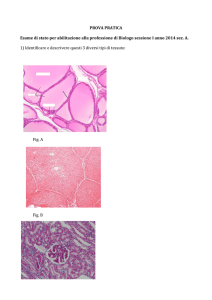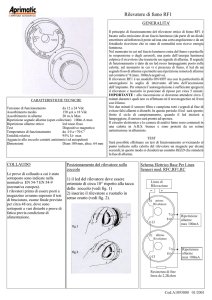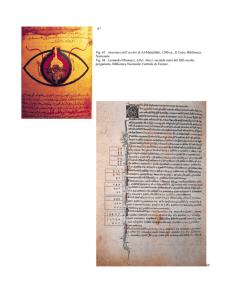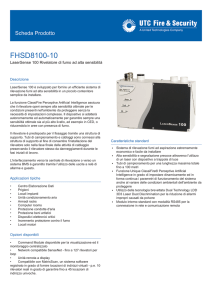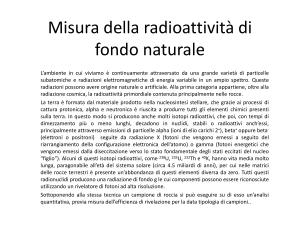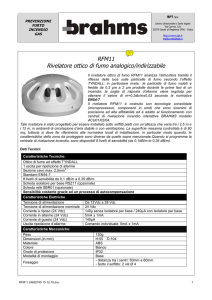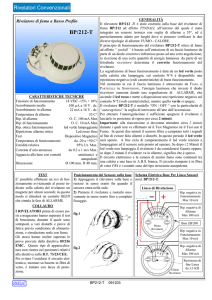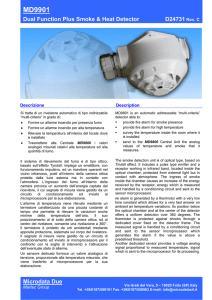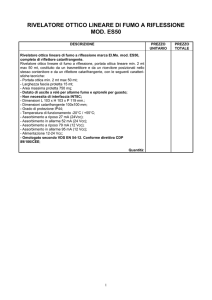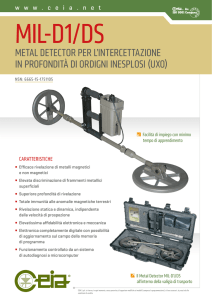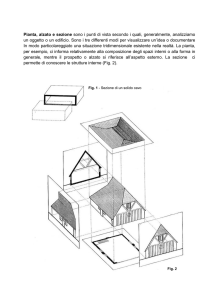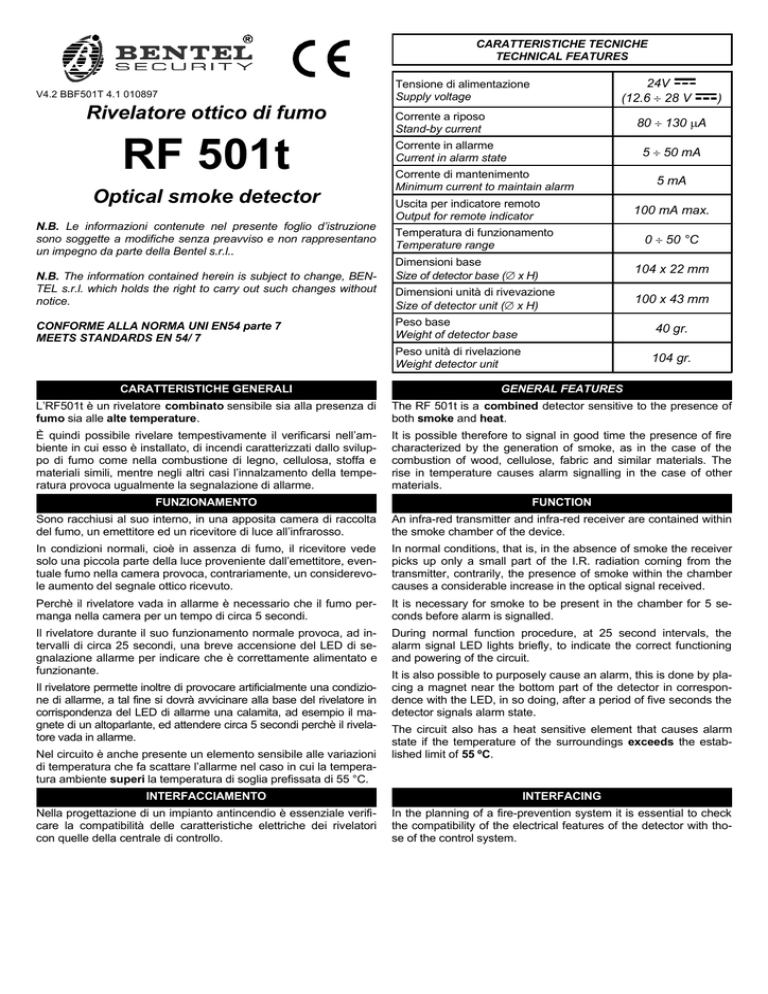
CARATTERISTICHE TECNICHE
TECHNICAL FEATURES
V4.2 BBF501T 4.1 010897
Rivelatore ottico di fumo
RF 501t
Optical smoke detector
N.B. Le informazioni contenute nel presente foglio d’istruzione
sono soggette a modifiche senza preavviso e non rappresentano
un impegno da parte della Bentel s.r.l..
N.B. The information contained herein is subject to change, BENTEL s.r.l. which holds the right to carry out such changes without
notice.
CONFORME ALLA NORMA UNI EN54 parte 7
MEETS STANDARDS EN 54/ 7
24V
(12.6 ÷ 28 V
Tensione di alimentazione
Supply voltage
Corrente a riposo
Stand-by current
)
80 ÷ 130 µA
Corrente in allarme
Current in alarm state
5 ÷ 50 mA
Corrente di mantenimento
Minimum current to maintain alarm
Uscita per indicatore remoto
Output for remote indicator
Temperatura di funzionamento
Temperature range
5 mA
100 mA max.
0 ÷ 50 °C
Dimensioni base
Size of detector base (∅ x H)
104 x 22 mm
Dimensioni unità di rivevazione
Size of detector unit (∅ x H)
100 x 43 mm
Peso base
Weight of detector base
40 gr.
Peso unità di rivelazione
Weight detector unit
104 gr.
CARATTERISTICHE GENERALI
GENERAL FEATURES
L’RF501t è un rivelatore combinato sensibile sia alla presenza di
fumo sia alle alte temperature.
The RF 501t is a combined detector sensitive to the presence of
both smoke and heat.
È quindi possibile rivelare tempestivamente il verificarsi nell’ambiente in cui esso è installato, di incendi caratterizzati dallo sviluppo di fumo come nella combustione di legno, cellulosa, stoffa e
materiali simili, mentre negli altri casi l’innalzamento della temperatura provoca ugualmente la segnalazione di allarme.
It is possible therefore to signal in good time the presence of fire
characterized by the generation of smoke, as in the case of the
combustion of wood, cellulose, fabric and similar materials. The
rise in temperature causes alarm signalling in the case of other
materials.
FUNZIONAMENTO
FUNCTION
Sono racchiusi al suo interno, in una apposita camera di raccolta
del fumo, un emettitore ed un ricevitore di luce all’infrarosso.
An infra-red transmitter and infra-red receiver are contained within
the smoke chamber of the device.
In condizioni normali, cioè in assenza di fumo, il ricevitore vede
solo una piccola parte della luce proveniente dall’emettitore, eventuale fumo nella camera provoca, contrariamente, un considerevole aumento del segnale ottico ricevuto.
In normal conditions, that is, in the absence of smoke the receiver
picks up only a small part of the I.R. radiation coming from the
transmitter, contrarily, the presence of smoke within the chamber
causes a considerable increase in the optical signal received.
Perchè il rivelatore vada in allarme è necessario che il fumo permanga nella camera per un tempo di circa 5 secondi.
It is necessary for smoke to be present in the chamber for 5 seconds before alarm is signalled.
Il rivelatore durante il suo funzionamento normale provoca, ad intervalli di circa 25 secondi, una breve accensione del LED di segnalazione allarme per indicare che è correttamente alimentato e
funzionante.
During normal function procedure, at 25 second intervals, the
alarm signal LED lights briefly, to indicate the correct functioning
and powering of the circuit.
Il rivelatore permette inoltre di provocare artificialmente una condizione di allarme, a tal fine si dovrà avvicinare alla base del rivelatore in
corrispondenza del LED di allarme una calamita, ad esempio il magnete di un altoparlante, ed attendere circa 5 secondi perchè il rivelatore vada in allarme.
Nel circuito è anche presente un elemento sensibile alle variazioni
di temperatura che fa scattare l’allarme nel caso in cui la temperatura ambiente superi la temperatura di soglia prefissata di 55 °C.
It is also possible to purposely cause an alarm, this is done by placing a magnet near the bottom part of the detector in correspondence with the LED, in so doing, after a period of five seconds the
detector signals alarm state.
The circuit also has a heat sensitive element that causes alarm
state if the temperature of the surroundings exceeds the established limit of 55 ºC.
INTERFACCIAMENTO
INTERFACING
Nella progettazione di un impianto antincendio è essenziale verificare la compatibilità delle caratteristiche elettriche dei rivelatori
con quelle della centrale di controllo.
In the planning of a fire-prevention system it is essential to check
the compatibility of the electrical features of the detector with those of the control system.
FIG. 1 Collegamento con spia remota distinta.
FIG. 2 Collegamento con spia remota in comune
Connection with separate remote indicator.
Connection with the same remote indicator.
Va verificata, innanzitutto, la tensione di alimentazione della linea che
nella maggior parte delle centrali è di 24 Volt; il rivelatore RF 501t funziona con tensioni di linea comprese tra 12 e 30 Volt ed ha un consumo a riposo inferiore a 100 µA (24 Volt).
Above all it is necessary to verify the voltage of the control panel
line, which in most systems is 24 Volts; the RF 501t functions with
line tensions between 12 and 30 Volts and has a stand-by current
of 100 µA (24 Volts).
Da verificare, inoltre, la corrente assorbilta dal rivelatore in caso di allarme che deve essere compresa tra i limiti imposti dalla centrale.
It is also necessary to check current absorption on the detector in
the case of alarm, this must be within the limits on the system.
Da questo punto di vista il rivelatore RF 501t in condizione di allarme può essere considerato come una resistenza di 470 ohm con
in serie una caduta di tensione di 3 Volt.
In alarm conditions the RF 501t detector may be considered as a
resistance of 470 ohm with, in series, a drop in tension of 3 Volts.
Shown in fig. 3 is typical of Tension/Current when alarm is verified.
La caratteristica Tensione/Corrente in allarme e mostrata in fig. 3.
COLLEGAMENTI ELETTRICI
ELECTRICAL CONNECTION
In fig. 1 è rappresentato un tipico circuito di zona comprendente 3
rivelatori con linea di collegamento a 2 fili.
Fig. 1 illustrates a typical zone circuit with 3 detectors with a 2 wire
connecting line.
Alla fine della linea è presente un diodo od una resistenza di fine
linea (r.f.l.) il cui valore dipende dalla centrale usata.
A diode or a line end resistance (l.e.r.) is present, the value of
which depending on the system in question.
La lampada di ripetizione (L.R.), collegata al morsetto [R], deve essere
alimentata da una linea di alimentazione separata come si vede in fig. 1.
The repeater light (R.L.), connected to clip [R], is to be powered by
a separate line as shown in fig. 2.
L’assorbimento di ogni lampada deve essere al massimo di 100 mA.
The current of each light is to be at the most 100 mA.
Nel caso di più rivelatori installati nella medesima stanza, può essere
utile installare una sola lampada remota per il monitoraggio di tutti i rivelatori, in questo caso il collegamento va effettuato come in fig. 2.
When several detectors are to be installed in one room, it may be of
benefit to install only one remote light for the monitoring of all the detectors, in this case the connection is to be carried out as in fig. 2.
INSTALLAZIONE
INSTALLATION
Il rivelatore RF 501t è composto da 2 parti separate: l’unità di rivelazione vera e propia e la base (fig. 4).
The RF 501t detector is made up of 2 separate parts: the base
(fig. 4) and the actual detector.
Effettuati i collegamenti ai 4 contatti a molla posti sulla base essa
va fissata al soffitto per mezzo di 2 viti Fisher.
When the 4 spring contacts, situated on the base, are connected,
fit the device to the ceiling by means of two Fisher screws.
L’unità di rivelazione viene bloccata avvitandola sulla base in senso antiorario.
Screw the remaining unit onto the base in an anti clockwise manner.
The detector is to be fitted at least 60 cm from surrounding walls or
from any other object that may obstruct the flow of air towards it.
Il rivelatore va montato ad almeno 60 cm di distanza da muri o da qualunque altro oggetto che possa bloccare il flusso d’aria verso lo stesso.
FIG. 3 Corrente di allarme in funzione della tensione
Alarm current (I) versus voltage (V).
FIG. 4 Base del rivelatore
Detector base.

